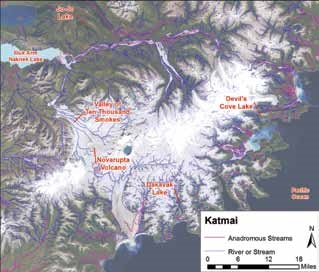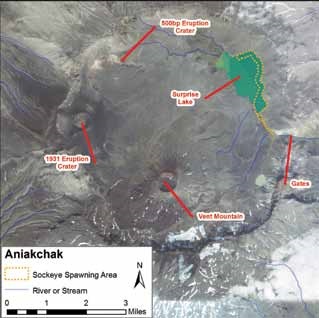
Volcanic activity can alter freshwater habitats dramatically, including major changes to water chemistry, turbidity, temperature, and channel morphology (Lucas 1986). These effects can severely impact fish popula-tions living in the waters during the eruption, and the longer-term effects are also generally negative. However, along the Alaska Peninsula, a zone of some significant historic and pre-historic eruptions, these effects coexist with some of the most productive salmon populations on earth (Hilborn et al. 2003). Studies conducted in the area of three of the Alaska Peninsula volcanoes shed some light both on the effects of volcanic activity on salmon populations in freshwater, as well as on the process of recolonization after an eruption (Figure 1).
The most recent evidence of major impacts from volcanic activity to freshwater habitats on the Alaska Peninsula comes from the acidification of Mother Goose Lake, within the Alaska Peninsula Wildlife Refuge (Figure 2). In 2005, the summit crater of Mount Chiginagak drained rapidly, resulting in a flood containing waters that were highly acidic. The arrival of this water into Mother Goose Lake resulted in the pH dropping to 3, a level of acidity that approaches the acidity of cola beverages. The acid killed all aquatic life and damaged riparian vegetation for miles downriver(McGimsey et al. 2008, Schaefer et al. 2011). The acidity of Mother Goose Lake has declined, resulting in pH climbing to around 7, which would be considered normal, by 2011 (Schaefer et al. 2011). While Mother Goose Lake and downstream waters were acidified, the Needle Lake drainage, a tributary to Indecision Creek which drains into Mother Goose Lake, was not. The value of small refugia such as the Needle Lake area in relation to the other large-scale freshwater drainages nearby (such as the Ugashik Lakes) is an active field of research, and systems like Mother Goose Lake are vital to the study of natural recolonization. It is very important to study natural recolonization, because human attempts in establishing reproducing populations of anadromous salmon rarely succeed (Wood 1995).

In 1912, the massive eruption of Novarupta Volcano filled an entire river valley with pyroclastic flow deposits, creating the Valley of Ten Thousand Smokes (Figure 3). Fish populations within the valley would have been wiped out, and ash falling in other nearby waters likely had an impact on those populations as well. Present day water conditions in the valley are still affected by this event. Water is highly turbid as it flows through the ash sheet in water courses cut deep into the welded tuff that constitutes the valley floor. The ash particles that are transported in the water are likely to disrupt fish respira-tion by damaging gill membranes. However, this same effect of turbid water can be seen from glacial silt, and we now know that there are spawning populations of salmon that make use of glacial systems (e.g. Ramstad et al. 2010). A waterfall on the Ukak River prevents fish from accessing the streams draining the valley, but information about fish in waters draining from the valley on all sides is sparse. It is possible that turbid habitats are widely used by salmon, but they are more difficult to study, because spawning fish cannot be seen by airplane, or even by walking alongside the river.
While the impacts of the pyroclastic flow that formed the Valley of Ten Thousand Smokes are clearly demon-strated by the altered landscape that persists to this day, the effects of the ash fall outside the valley are less certain. Though major ash deposition was reported as far away as Kodiak Island, recent work in Katmai has demonstrated that this ash fall was unlikely to have destroyed fish populations in lakes within the park. Though most of the waterbodies in Katmai ultimately connect to the ocean, one interesting avenue of study is to look at fish assemblages that are landlocked or not connected to the ocean. Kokanee, which are landlocked sockeye salmon (Oncorhynchus nerka), occur in three lakes within Katmai. Each lake is between 10 and 25 miles from Novarupta Volcano. Sediment core analysis has indicated that Jo-Jo Lake (about 25 miles northwest of Novarupta) was a basin of Naknek Lake that was eventually shut off as the Naknek Lake level dropped over the past thousands of years. The most recent contiguous water flow with Naknek Lake appears to have occurred more than 200 years ago, well before the Novarupta eruption, but the lake has populations of kokanee as well as other fresh-water fish that must have persisted through the ash fall.

Devil’s Cove Lake (about 20 miles northeast of Novarupta) has a barrier waterfall that is well over 15 feet in height on the outlet river. The height of the waterfall precludes a recent origin for this barrier, and the lake lies in the main path of volcanic ash from the eruption, but this lake is also inhabited by kokanee, as well as other freshwater fish.
Finally, Dakavak Lake (12 miles southeast of Novarup-ta) has a barrier that is formed by a debris-choked ravine with subterranean flow. All water draining from the lake leaves through this massive debris field, emerging at the bottom of the slope. The origin of the debris field has not been ascertained. Attempts to core the lake were unsuc-cessful because the Novarupta ash layer was so dense it could not be penetrated. This lake might benefit from more intensive work to determine the origin of the outlet debris field. If the debris field was created by Novarupta ejecta, the timing of the actual barrier formation could have followed the eruption and the kokanee and other fish present might have established in the lake after the eruption and before the debris jam, but at this time it cannot be ruled out that these populations survived the massive ash fall mere miles from the eruption.

Aniakchak Caldera was formed around 3,500 years ago by an eruption that dwarfed even the Novarupta eruption (Figure 4)(McGimsey et al. 1994). Following that large eruption, which formed Aniakchak Caldera, a crater lake formed within the caldera, and somewhere around 2,000 years ago that lake drained in a catastrophic dam-failure flood (Waythomas et al. 1996, VanderHoek and Myron 2004). Following this flood, the smaller remnant water body in the caldera, Surprise Lake, was connected to the Pacific Ocean and therefore accessible to colonization by anadromous fish. Subsequent eruptive activity has included a moderate eruption 500 years ago and another smaller one in 1931. Genetic studies of the current sockeye populations in the caldera indicate they were wiped out and started anew following the 500 year old eruption, but likely persisted through the 1931 eruption (Pavey et al. 2010). The caldera is still dominated in appearance by the volcanic setting, as vegetation is sparse except along the lake shore, where years of dead, post spawning sockeye transported enough nutrients to the soil to support plants. Water quality in the lake is affected by water draining into the lake from the interior of the caldera that is high in metals and low in dissolved oxygen, while the water from snowmelt coming in from the caldera wall is much more amenable to aquatic life.
Fisheries inventory work has confirmed that there are no fish populations in any flowing waters entering the up-per end of Surprise Lake from the interior of the caldera. The streams draining the caldera wall are too small to allow upstream fish passage, but they bring water into the lake as groundwater that supports substantial sockeye spawning activity. As a result of this pattern, sockeye populations spawn all around the caldera wall side of the lake, and in the river below the lake outlet, while the side of the lake on the interior of the caldera has no spawning activity (Pavey et al. 2007). Like Mother Goose Lake, this is a very rare example of relatively recent colonization. The park has spearheaded several research projects of this event. One of the findings is that the sockeye have locally adapted to different habitats in the caldera. The sockeye spawning in the outlet river are more streamlined than those spawning on the beaches, as they must swim against a swift current to maintain their spawning positions (Pavey et al. 2010).Within the lake itself, fish are subject to the waters that come in from the interior of the caldera. In comparison to sockeye from populations outside the caldera, Surprise Lake juvenile sockeye express more genes associated with metabolizing heavy metals, likely to assist with survival in these conditions (Pavey et al. 2011).
Summary
While volcanic eruptions have major effects on fish populations, those impacts decrease rapidly with distance from the eruptive center. The habitat diversity created by volcanic activity on the landscape may spur additional biodiversity within species, contributing to the overall fisheries productivity of these regions.
References
Hilborn, R., T.P. Quinn, D.E. Schindler, and D.E. Rogers. 2003. Biocomplexity and fisheries sustainability. Proceedings of the National Academy of Sciences 100:6564-6568.
Lucas, R.E. 1986. Recovery of game fish populations impacted by the May 18, 1980 eruption of Mount St. Helens: winter-run steelhead in the Toutle River watershed. In Mount St. Helens: Five Years Later, edited by S.E.C. Keller, pp 276-292. Eastern Washington University Press. Cheney, WA.
McGimsey, R.G., C.A. Neal, J.P. Dixon, and S. Ushakov. 2008. 2005 volcanic activity in Alaska, Kamchatka, and the Kurile Islands: summary of events and response of the Alaska Volcano Observatory. U.S. Geological Survey Scientific Investigations Report 2007-5269.
McGimsey, R.G., C.F. Waythomas, and C.A. Neal. 1994. High stand and catastrophic draining of intracaldera Surprise Lake, Aniakchak Volcano, Alaska. In Geologic studies in Alaska by the U.S. Geological Survey, edited by A.B. Till and T.E. Moore, pp. 59-71. U.S. Geological Survey Bulletin.
Pavey, S.A., B. Sutherland, J. Leong, A. Robb, K. von Schalburg, T. Hamon, B. Koop, and J. Nielsen. 2011. Ecological transcriptomics of lake-type and riverine sockeye salmon (Oncorhynchusnerka). BMC Ecology 11:31.
Pavey, S.A., T.R. Hamon, and J.L. Nielsen. 2007. Revisiting evolutionary dead ends in sockeye salmon (Oncorhynchusnerka) life history. Canadian Journal of Fisheries and Aquatic Sciences 64:119-1208.
Pavey, S.A., J.L. Nielsen, and T.R. Hamon. 2010. Recent ecological divergence despite migration in sockeye salmon (Oncorhynchusnerka). Evolution 64:1773-1783.
Ramstad, K.M., C.A. Woody, and F.W. Allendorf. 2010. Recent local adaptation of sockeye salmon to glacial spawning habitats. Evolutionary Ecology 24:391-411.
Schaefer, J.R., W.E. Scott, W.C. Evans, B. Wang, and R.G. McGimsey. 2011. Summit crater lake observations, and the location, chemistry, and pH of water samples near Mount Chiginagak
Volcano, Alaska: 2004-2011. State of Alaska, Department of Natural Resources, Division of Geological and Geophysical Surveys, Report of Investigations 2011-6.
VanderHoek, R., and R. Myron. 2004. Cultural Remains from a catastrophic landscape: an archeological overview and assessment of Aniakchak National Monument and Preserve. National Park Service AR/CRR-2004-47.Anchorage, Alaska.
Waythomas, C.F., J.S. Walder, R.G. McGimsey, and C.A. Neal. 1996. A catastrophic flood caused by drainage of a caldera lake at Aniakchak volcano, Alaska, and implications for volcanic hazards assessment. Geological Society of America Bulletin 108:861-871.
Wood, C.C. 1995. Life history variation and population structure in sockeye salmon. In Evolution and the aquatic ecosystem: Defining unique units in population conservation, edited by J.L. Nielsen. American Fisheries Society Symposium 17: 195-216.
Part of a series of articles titled Alaska Park Science - Volume 11 Issue 2: Science in Southwest Alaska.
Last updated: June 13, 2016
